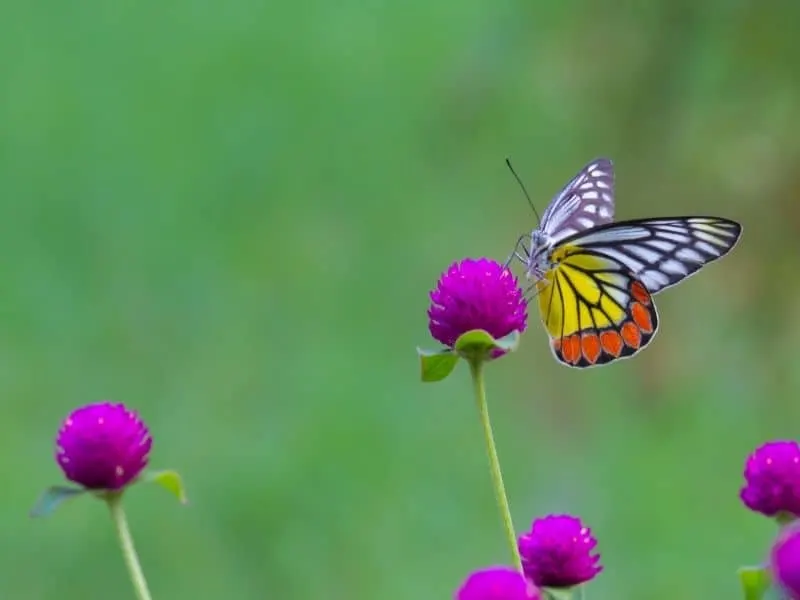Among the many joys of gardening are the wonderful creatures that visit our outdoor spaces. Bees, hummingbirds, butterflies, songbirds, toads, ladybugs, and many others add another dimension of beauty to the flowers and foliage in our yards. To further recognize and appreciate one category of these special visitors, March 14 has been designated Learn About Butterflies Day.

Learn About Butterflies Day (March 14)
In addition to their stunning appearance, butterflies have much to offer. Perhaps the best-known benefit is that butterflies pollinate a wide range of plants, from wildflowers to fruit and vegetable crops.
Their presence also indicates a healthy ecosystem: an area that supports butterflies likely hosts many other invertebrates as well. And while we don’t like to think of butterflies being eaten, they serve as an important food source for birds, bats, and other insectivores.
How you can learn about butterflies
Want to learn more about these amazing insects? There are many excellent resources and activities available for studying butterflies. Check out a few of these options for celebrating Learn About Butterflies Day and discovering how butterflies fit into your garden as well as the larger world.
1. Read books and online resources
Books and websites are an excellent place to start your butterfly journey.
- The North American Butterfly Association (NABA) website provides an excellent FAQ page, lists of North American butterflies, and a wealth of other information.
- NABA publishes two magazines, American Butterflies and Butterfly Gardener, which may be worth subscribing to, or you can read a selection of articles on the website.
- The Life Cycles of Butterflies by Judy Burris provides “a visual guide to 23 common garden butterflies” for both children and adults.
- Purchase a guide like The National Audubon Society Field Guide to North American Butterflies if you would like to learn how to properly identify butterflies in your garden and throughout the continent.
- The resources page of The Lepidopterists’ Society website offers everything from classroom tools to hands-on citizen science projects.
- Read species profiles on the Butterflies and Moths of North America website, where you can also submit photos to help them collect and share information about butterflies and moths.
2. Visit a butterfly center
Another great way to learn about butterflies is to get up close and personal at a conservation center, zoo, botanical garden, or another educational center.
The National Butterfly Center is located in Mission, Texas, but many other options exist as well, such as Butterfly Pavilion in Westminster, Colorado; Butterfly World in Coconut Creek, Florida; or The Butterfly Conservatory at the American Museum of Natural History in New York City.
A quick search online should bring up a butterfly center in your area, or you can look up a nearby zoo, wildlife center, or garden to see if they have an exhibit.
3. Plant a butterfly garden
You can also celebrate Learn About Butterflies Day by planning a butterfly garden to help support local butterfly populations as well as study them. As an added bonus, you will be providing habitat for bees, birds, and other native creatures as well.
Choose wildflowers native to your area, especially those with warm hues such as yellow, orange, red, pink, and even purple. Short flower tubes and flat-topped or clustered shapes are also often preferred by butterflies.
Consider the full lifecycle of butterflies and provide them with a variety of host plants attractive to both caterpillars and mature butterflies. In addition to plants, flat stones will give butterflies a place to rest, and shallow pans filled with moist sand serve as sources of water and minerals.
For more information, The National Wildlife Federation provides a good overview of butterfly gardening, while NABA offers in-depth tips as well as a butterfly garden certification program.
Whether you read a webpage or plan a whole new garden, I hope you enjoy discovering more about these amazing insects on Learn About Butterflies Day.

Serena Manickam is a freelance editor and writer and sustainable market gardener in rural Virginia. She holds a BA in environmental science and runs Fairydiddle Farm, a small market garden in which she grows no-spray produce and herbs to sell at a local farmer’s market.


Connecticut Native Plants List: 14 Beautiful Flower Garden Choices
Monday 9th of August 2021
[…] It has separate male and female flowers, and they can take on gender-specific shades of yellow. Butterflies love them, making them a great choice in your […]